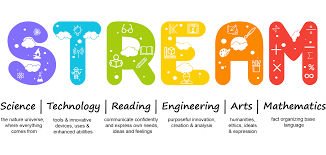


“STREAM : Science and Technology, interpreted through Engineering and the Arts, conveyed through reading and writing, all based in elements of Mathematics.” By Georgette Yakman
STEM Education
STEM is an educational curriculum that combines science, technology, engineering, and math. It is meant to be a comprehensive approach; instead of teaching each subject separately, educators aim to incorporate some or all elements of STEM into each project.
Common STEM projects include things like engineer and basic computer programming, though the opportunities are seemingly endless.
While the objectives of any particular school’s STEM program may vary, two overall goals of STEM are to broaden STEM literacy and participation, particularly among young women and people of color, as well as to strengthen the STEM workforce by increasing the number of students who pursue a career in a related field.
STREAM Education
STREAM adds one more layer to STEM and STEAM: Reading and wRiting. Advocates of STREAM see literacy skills as an essential part of a well-rounded curriculum, as it requires critical thinking as well as creativity. STREAM projects are similar to STEM or STEAM, but fold in the components of Reading and wRiting.
The Evolution of STEM into STREAM
"If you want to train innovative and successful scientists, there isn't any doubt that you want to teach them to love and cherish writing." By Robert and Michele Root-Bernstein
"Turning STEM into STREAM: Writing as an Essential Component of Science Education"
“Integrated Learning” - that’s all this is.
Every kid needs to have technology literacy and problem-solving skills!
STREAM has the potential to be more approachable and inclusive than STEM with the value in a more robust curriculum that includes reading and writing.
STREAM covers life-skills such as communication, collaboration, critical thinking, problem-solving, literacy skills as core and helps in the overall development of a child.
Writing isn't just wordsmithing. It also teaches mastery of the creative process. Whether one is writing fiction or nonfiction, creative nonfiction or poetry, the process of taking inchoate facts, trends, feelings, impressions, images, and emotions and translating them into words requires mastery of all the tools for thinking required to perform any other creative activity. Moreover, since words are our primary means of communicating, anyone who has not mastered their creative use is simply underprepared for any discipline, including STEM subjects.